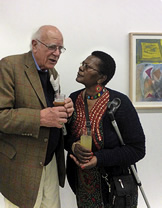 |
|||||||||
|
Louis Maqhubela
1939-2021
Very sadly Louis Maqhubela and his wife Tana died from Covid-19 within days of one another in October. It is devastating for the family, Lindi, Tsiki and Thami, and the cherished grandchildren. Our hearts go out to them. Tributes and messages of affection from fellow artists and collectors reflect their warm admiration and respect for Maqhubela’s art of spiritual abstraction and radiance, suffused with memories of his earlier life in South Africa. His legacy is significant and is well recorded in the book A Vigil of Departure – Louis Khehla Maqhubela; a retrospective 1960 – 2010which accompanied his exhibition at the Standard Bank Gallery in Johannesburg, curated by Marilyn Martin. The Maqhubela’s were exuberantly welcomed to the opening, attended by family members and South African friends, artists, and key figures active in the newly democratic South Africa. The exhibition travelled to the Iziko S A National Gallery and the Durban Art Gallery.
RIP dear Louis and Tana.
Biography
Louis Khela Maqhubela was born in 1939 in Durban, South Africa. He studied under Cecil Skotnes and Sydney Komalo at the Polly Street Centre, Johannesburg. After leaving South Africa, he settled in London in 1978, where he undertook further studies at Goldsmiths College in 1984 and the Slade School of Art between 1985–1988.
From early figurative scenes of township life in Johannesburg, Maqhubela evolved a more abstract mode of painting, becoming one of the pioneers of modern art in South Africa. His work is characterised by a specific language of forms which float or move in a radiant, atmospheric space. Sometimes a graphic element of thin black lines appears describing animals or human figures. In spirit and form they evoke Paul Klee but what they describe is part of Maqhubela's African narrative. Recent canvases refer increasingly to traditional African forms; Pondo, Zulu, Ndbele–all of them filtered through memory and arranged in a magical, lyrical coloured space with richly worked surface textures.
Painting on canvas, oil or gouache on paper, he was recognised early in his career in South Africa, where in 1967 he was hailed as the first black painter of distinction with first prize in the Adler Fielding Gallery's Artists of Fame and Promise exhibition. The award came with a three month travel bursary to Europe and the UK. After further prizes, he left South Africa in 1973, moving first to Spain, and then London, where he has lived and worked ever since.
Maqhubela visited South Africa in the momentous year of 1994 when Mandela was elected President, and again in 2001, 2002, 2004, and recently in 2010, for the opening of his major retrospective exhibition, A Vigil of Departure (1960–2010). This long awaited survey opened at the Standard Bank Gallery, Johannesburg and toured to Iziko National Gallery Cape Town, and to the Durban Art Gallery, Natal. Marilyn Martin, former Director of the South African National Gallery, was both curator and the author of the distinguished catalogue which accompanied the exhibition. This was the first occasion on which Maqhubela's work drawn from five decades, could be viewed in his own country.
Maqhubela's paintings and drawings have entered the Iziko National Gallery of South Africa and Johannesburg Art Gallery collections, as well as the majority of corporate and public collections throughout South Africa. In London he is represented at the Victoria & Albert Museum, and in the USA by the National Museum of African Art, Smithsonian Institution, Washington DC.



